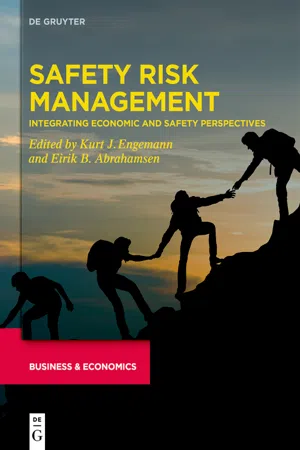1.1 Introduction
Every business or non-profit enterprise must manage internal and external risks. A bank may be concerned about foreign exchange risk, political risk, operational risk, and compliance risk with government regulations. A large oil company might also be concerned with political risk, along with risks involving prices in oil markets and risks associated with the availability of oil tankers. A hospital may be concerned about the risk of in-hospital infectious diseases. A software developer might be concerned with hiring and maintaining a staff of high performing engineers, and navigating evolving technological and regulatory environments.
By exploiting risk, we mean thoroughly understanding the overall risk environment and using that understanding to proceed with implementing future practices and making decisions. Individuals, groups, and organizations can all exploit risk. The practices and decisions used to exploit risk may be assessed according to various criteria, and for organizations, may include the level to which they meet or exceed competitive and regulatory requirements. They may be based on applying analytical decision-focused methodologies, as well as on using behavioral and organizational culture approaches to better navigate economic, technological, and political environments.
Exploiting risk involves navigating a “decision tightrope.” For example, analyzing decisions using known expected benefits and costs, also involves considering unexpected benefits and unexpected costs – both of which are by definition, mainly unknown, and whose impact may turn out to outweigh the initial expected information. One conservative approach is to employ the precautionary principle. When following this approach, an alternative may be dismissed to avoid unexpected costs, but this may also mean foregoing some unexpected benefits. An example would be risks involving potential accidents, where in a rush to avoid potential accidents (e.g., not taking a hiking trip in the mountains), a person also would forego possible benefits.
In this chapter we focus on analytical approaches to evaluate risk, primarily with respect to analyzing risk under uncertainty. We also discuss behaviorally oriented approaches, including presenting some tools that can be used to inform decisions and further action. Two analytical approaches are the classical regret-based approach, and a comfort-based approach. The regret-based approach looks at the world from a “glass half empty” perspective where, whatever outcome occurs, the decision maker ranks it in relation to the best possible outcome. In this respect, one is often not satisfied and always strives for more. The comfort-based approach is a “glass half full” approach where the decision maker looks at outcomes relative to the worst outcome (Engemann and Yager, 2018) . Here, the decision maker focuses on the degree of satisfaction achieved.
For example, suppose an investor purchases stock A for $100, but also could have purchased stocks B or C for the same amount. Stock A doubles in value, stock B quadruples, whereas stock C remains at $100. The profit for stocks A, B and C are $100, $300, and $0, respectively. Using a regret perspective, the investor’s regret for purchasing stock A is $200 – the $100 profit he ends up by investing in stock A is subtracted from the $300 profit that he could have realized by purchasing stock B. His comfort for stock A, however, is $100 – his $100 profit from stock A less the $0 profit he could have realized by buying stock C. Whereas viewing risk from a regret perspective is a “glass half empty” approach where he may be dissatisfied with “losing” $200, viewing risk from a comfort approach is a “glass half full” viewpoint where he is satisfied with his $100 profit. How the investor looks at his choices and the associated risks can inform his overall decision-making approach, and even psychological well-being.
These approaches map into exploiting risk in several ways that can be combined with other behavioral-based actions. Always analyzing future alternatives against outcomes in a perfect world may stifle future actions because possible alternatives may be viewed as not good enough. For example, a new product may not be implemented because a theoretical possibility of an accident or other problem might result in a no-go decision. A deficiency of the regret approach is that it can hinder future action. Always comparing existing performance with the optimal performance, and coming up short, may cause decision makers to decide to forgo a particular project and allocate resources elsewhere. A “glass half empty” approach might induce a tendency not to proceed on projects except those where the organization can be certain to come out on top. This may be akin to summiting many small hills, but never attempting to climb large mountains. In a competitive business environment, this can lead to paralyzing risk aversion, stagnation, and even bankruptcy.
A glass-half-full approach coupled with subject area knowledge can lead to companies outcompeting rivals when...
